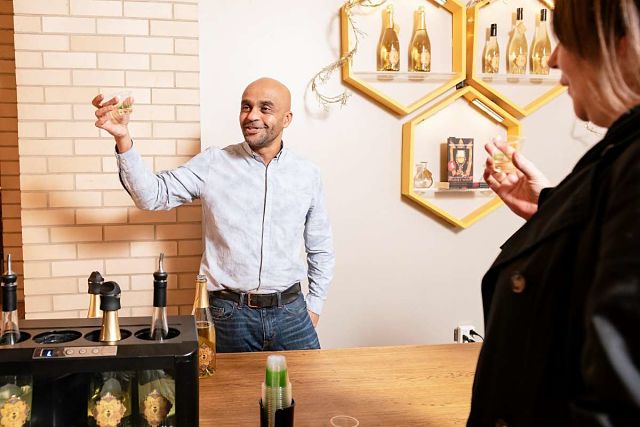 Owner Ayele Solomon describes his wines to guests during a tasting at Bee D'Vine Honey Wine Company's tasting bar in the Ferry Building in San Francisco, California, Thursday, January 9th, 2020. (Photo: Michael Short / Special to The Chronicle)
Owner Ayele Solomon describes his wines to guests during a tasting at Bee D'Vine Honey Wine Company's tasting bar in the Ferry Building in San Francisco, California, Thursday, January 9th, 2020. (Photo: Michael Short / Special to The Chronicle)
The San Francisco Chronicle
Ayele Solomon grew up drinking homemade t’ej in Ethiopia. He incorporates some of that tradition in his California honey-wine production, but brings a more scientific approach.
Wine made with honey, often called mead, could be the world’s oldest fermented beverage, with evidence suggesting it was consumed 7,000 years ago. Today, however, honey wine is a difficult sell, eclipsed by grape wines, craft beers and, lately, hard seltzer.
Many drinkers mistakenly assume that all mead is invariably sweet. They’ve been disappointed with mediocre versions they’ve tasted at Renaissance fairs. But makers of honey wine believe that sales would be much easier if they could just persuade potential buyers to take a sip. That isn’t easy, given that production sites are few and not as gussied up and romantic as winery tasting rooms. And only occasionally does a restaurant wine list include a section devoted to mead.
Ayele Solomon recognizes those drawbacks, so he has done something unusual for Northern California’s small but persistently hopeful community of honey-wine producers — in December, he opened a free-standing tasting bar in a prime San Francisco setting, the Ferry Building.
There, he daily pours samples of his four honey wines, one each dry and sweet, one each still and sparkling, inspired by the honey-wine tradition of his native Ethiopia, all under the brand Bee D’Vine.
Honey wine is a more universal way to describe the beverage and to indicate its stylistic sweep, he says. It also is the term used in Ethiopia, where it traditionally is known as t’ej…
From Ethiopia, he and his family migrated to Kenya and then to the United States, settling in the Bay Area in the mid-1980s. After earning a degree in environmental economics at UC Berkeley, he returned to Africa. There, his work as a conservationist — fostering economic opportunities for indigenous residents of the mountainous rain forest of Kafa in southwestern Ethiopia — reintroduced him to honey wine.
Read the full article at sfchronicle.com »
—
Related:
Sheba Tej: America’s Favorite Ethiopian Honey Wine
Join the conversation on Twitter and Facebook.

























